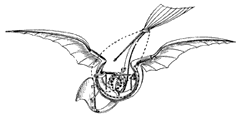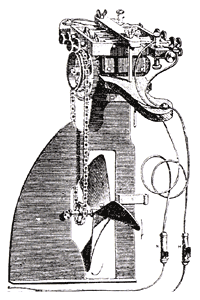
<-- A modern endoscope
Here's a tribute to the greatest inventor you've likely never heard of.
Gustav Trouve was a nineteenth century Frenchman who was first with so many things that I can't understand why his name is so obscure. I was doing some research on ornithopters for an article in Make Magazine when I first saw his name. The man seems to be a real polymath, a Gallic Edison.
Here's a short list of technical accomplishments I gathered from various sources on the Internet:
1. First Ornithopter

The first ornithopters capable of flight were constructed in France in the 1870s. Gustav Trouvé's 1870 model flew a distance of 70 meters in a demonstration for the French Academy of Sciences. The wings flapped by gunpowder charges activating a bourdon tube.2. Inventor of the "practical" Endoscope
In 1873, he was, in fact, the first to ... set an electric light at the tip of the endoscope, by using a small incandescent airtight bulb. Edison's "Mignon" bulb was only discovered after 1886.3. First outboard motor

Take the ubiquitous outboard motor that enabled millions of people to take to the water. French inventor Gustave Trouve developed the first practical marine outboard in 1880 -- and it was powered by electricity.4. First Electric Vehicle
Trouve and three friends cruised the Seine in silence aboard a 17-foot launch with an electric motor powered by two bichromate of potassium batteries. By 1890, Trouve motors powered 100 boats in Europe.
Apparently, the motor looked like this:
Trouve could not only lay claim to the world’s first marine outboard engine but, in taking the same motor and adapting it as the drive mechanism of a Coventry-Rotary pedal tricycle or velocipede, Trouve also pioneered the world’s first electric vehicle.5. Wearable Jewels (?)
On 1 August 1881 Trouve made his benchmark report to the French Academy of Sciences, stating: “I had the honour to submit to this Academy, in the session of 7th July 1880, a new electric motor based on the eccentricity of the Siemens coil flange. By suggestive studies, which have allowed me to reduce the weight of all the components of the motor, I have succeeded in obtaining an output which to me appears quite remarkable.
Gustave Trouvé, French engineer, developed a set of wearable electrical jewels for the performers in 1884. Trouvé custom built a portable accumulator for the performer’s costume on almost half a kilo, and built incandescent light bulbs into a design of colored glass to create an effect of sparkling jewels.So who is Gustave Trouve? I could find very little personal background on him, beside that he was a Frenchman who live in Paris, was born in 1839 and died in 1902. In between he obviously did a lot of inventing. I'd like to know more about this guy. Surely there must be something written on him. Most likely, whatever there is, is in French which I do not read.
The electrical jewels soon became a commercial commodity, but it was only in the larger cities where the user could charge the accumulator. The power supply lasted for only 30 minutes.

1 comment:
Strangely enough, before coming across your article, I just watched an episode of Make TV that mentioned Trouve and have been looking for information on him ever since. I am suprised that there is still little information, readily available on the internet, on him.
I realize that you wrote this article some time ago but was wondering if you had found any good resources?
Post a Comment